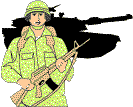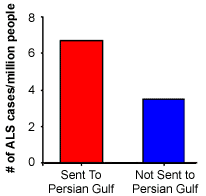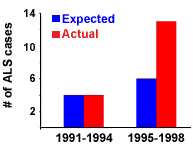 | Link Between ALS and Persian Gulf War Veterans Confirmed |
 | Link Between ALS and Persian Gulf War Veterans Confirmed |
|
By Ellen Kuwana Neuroscience for Kids Staff Writer  December 4, 2003
December 4, 2003When soldiers were shipped out to the Persian Gulf in 1991, they knew that there were risks. A soldier might get shot, exposed to chemical or biological weapons, or pick up a parasitic disease in the desert. Yet no one suspected that years later these Gulf War veterans -- in particular Air Force and Army personnel -- might develop the fatal neurodegenerative disease amyotrophic lateral sclerosis (ALS). A preliminary study published in 2001 found that ALS, also called Lou Gehrig's disease after the famous New York Yankee baseball player who contracted the disease, occurred in Gulf War veterans in surprisingly high numbers, and at surprisingly young ages. Two studies supporting the conclusions of the preliminary study were published in the September 23, 2003, issue of the journal Neurology. This publication marks the first time that the U.S. government has acknowledged a link between service in the Gulf War and the risk of developing a specific illness.
Study #1 Concludes: High Numbers of Gulf War Veterans Develop ALSRonnie D. Horner, Ph.D., and his colleagues at the National Institute of Neurological Disorders and Stroke (NINDS) analyzed the number of cases of ALS in Gulf War veterans as compared to other military personnel (not sent to the Persian Gulf) and the general population. The study found that Gulf War veterans were more than
twice as likely to develop ALS. War veterans were more than
twice as likely to develop ALS.
A closer look at the numbers:
Study #2 Concludes: Gulf War Veterans Develop ALS at a Young AgeALS rarely strikes before the age of 45, yet many Gulf War veterans are being diagnosed before they reach the age of 45. Researcher Robert W. Haley, M.D. of the University of Texas Southwestern Medical Center has published more than 100 papers on Gulf War Syndrome. Symptoms of this syndrome include fatigue, diarrhea, dizziness and muscle weakness. Haley's study focused on Gulf War veterans who were
diagnosed with ALS at the age of 45 or younger and examined how soon after
the Gulf War the veterans received their diagnosis. study focused on Gulf War veterans who were
diagnosed with ALS at the age of 45 or younger and examined how soon after
the Gulf War the veterans received their diagnosis.He found a total of 17 Gulf War veterans who were diagnosed with ALS between 1991 and 1998, before they were 45 years old. Based on the expected incidence of ALS in the U.S. population (those under 45 years old), one would expect 4 cases of ALS for the years 1991-1994 and 6 cases for the years 1995-1998. Haley found 4 cases for 1991-1994 as expected -- this means that the incidence of ALS in Gulf War veterans was not unusually high in the few years after they first returned to the United States. But he found 13 cases (6 expected) for 1995-1998. This suggests that young Gulf War veterans are developing ALS as the years go by; the trend suggests that more and more Gulf War veterans will be diagnosed with ALS with each passing year.
Future Research Directions It is important to note that ALS is a relatively rare
disease, even among veterans. The increased incidence and the young age of
onset are both important clues for researchers. This study was vital for
confirming the link between service in the Gulf War and an early onset of
ALS. It did not, however, address why Gulf War veterans have an
increased risk of developing ALS, or what the trigger may be.
Future research will focus on these questions. It is important to note that ALS is a relatively rare
disease, even among veterans. The increased incidence and the young age of
onset are both important clues for researchers. This study was vital for
confirming the link between service in the Gulf War and an early onset of
ALS. It did not, however, address why Gulf War veterans have an
increased risk of developing ALS, or what the trigger may be.
Future research will focus on these questions.The Department of Veterans Affairs offers disability and survivor benefits to any veterans with ALS. A national ALS registry for veterans has been set up to track veterans with the disease. Call 1-877-DIAL ALS for more information. |
Did You Know?
|
|
|
References:
|
| GO TO: | Neuroscience In The News | Explore the Nervous System | Table of Contents |
![[email]](./gif/menue.gif) Send E-mail |
 Fill out survey |
 Get Newsletter |
 Search Pages |
 Take Notes |